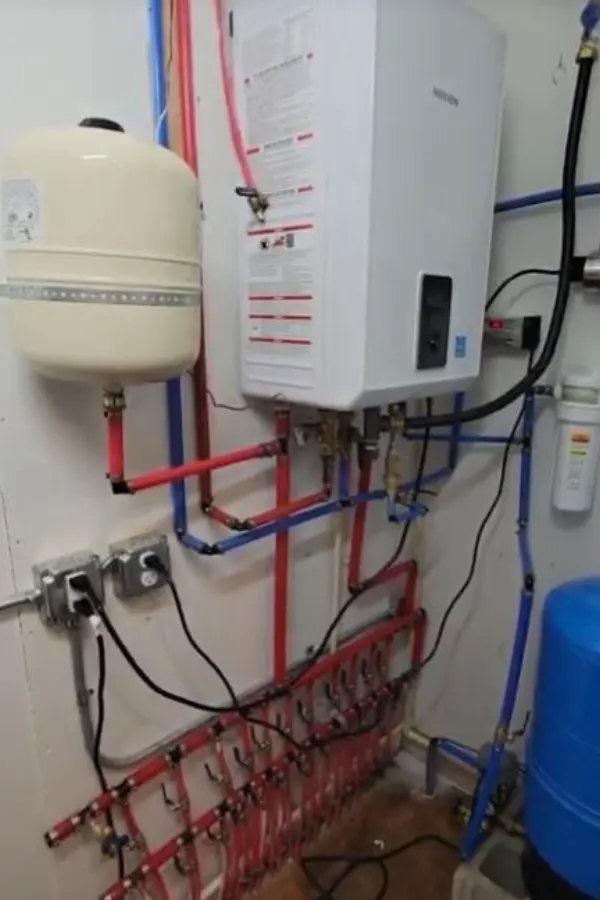If there is one winter topic that drives a tremendous amount of email traffic to our inbox, it’s the subject of why we use on demand radiant floor heat in all of our cabins, homes and buildings at the farm – and perhaps more to the point, how does it work and what does it cost to install and operate.
Quite honestly, we have now used this set-up in over 10 structures in the last 8 years. And we will continue to use it in every new build in the future. Why? Because when compared to other methods for heating a home – it can’t be beat.
Not in the cost of installation. Not in the cost to operate it as our main heat source. And best of all, it certainly can’t be beat in how much warmth and comfort it provides when compared to traditional forced air heating systems.

One thing is for sure, if you are looking for an incredible way to heat your house, garage, barn, greenhouse or whatever structure you can dream up, on demand radiant floor heat is the way to go. Especially if you happen to be building or remodeling in the near future!
With all of those benefits in mind, here is an in depth look at all of the benefits of on demand radiant floor heating, along with how it works and goes in – and most importantly, what it costs to install and operate.
On Demand Radiant Floor Heat – How It Works And What It Costs To Install
The Benefits
Let’s first cover all of the benefits of an on demand heating system. For starters, an on demand radiant floor heating system is amazingly uncomplicated. Although it can be installed underneath an existing tile, laminate, stone, wood or even carpeted floor, we install all of our systems directly into our concrete slabs before they are poured.
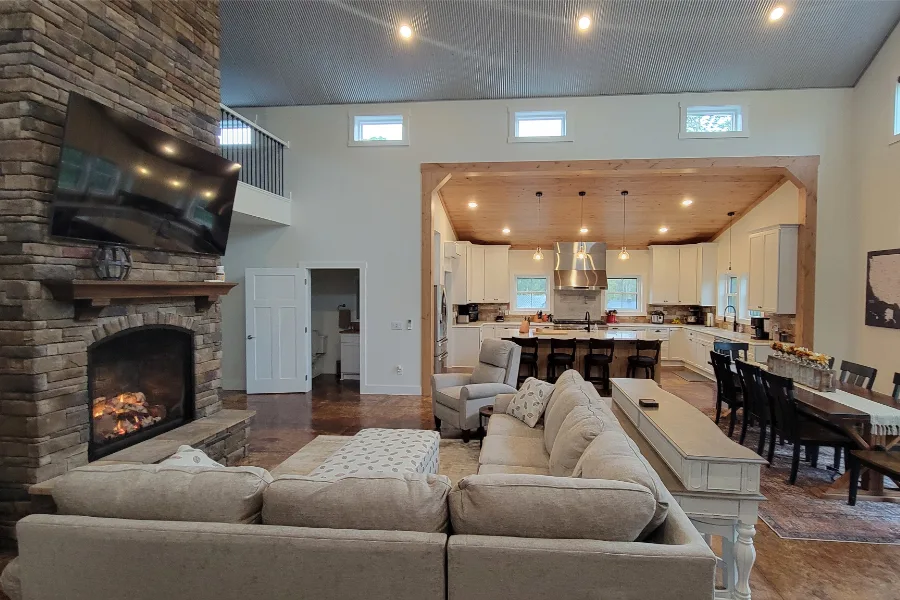
This method is by far the easiest and least expensive option of all. Of course, when doing so, it does have to be new construction or a major remodel. There are many types of radiant floor heat, and they all certainly can heat a space efficiently. But an on demand radiant floor system in a concrete slab takes those efficiencies to the next level.
The system is designed around a central unit that heats the water as needed and only when needed. Instead of having a boiler or hot water tank that keeps a reserve of warm water, the water flows through the central unit for hot water on demand.
A Video Walk Through Of Installing On Demand Floor Heat
Choosing A Fuel…
The system can run on propane or natural gas, and the heating jets only fire when hot water is requested. This is where the savings really happen. No need for constantly heating a tank of water that is sitting idle. But even better, when you purchase a dual system tank, you can also use it to have on demand hot water for your entire home.
That means we can eliminate the need not just for an expensive forced air furnace, but for a hot water tank as well. Even better, the efficiency of an on-demand hot water tanks saves on monthly bills too!
Does It Provide Enough Heat? On Demand Radiant Floor Heat
We get so many emails about the system’s ability to heat our entire home. It has NEVER been a problem. For us, the system was true love at first warmth! Not only for the amazing way it heated our entire house, but also for just how efficiently it did so.
We have now been in our new barndominium for two winters. We heat with propane as we have no ability to get natural gas. Even with that, in the coldest month of the year, we spend less than $150!
That figure becomes even more amazing when you consider that not only do we heat our entire home with gas, but also use it to heat all of our hot water and to power our home’s gas stove!
But it truly is the warming qualities of the floor we love most. There is nothing quite like stepping out of bed on a cold winter night and having your feet feeling warmth from below. And even better, no drafty vents blowing air into your face.
What About Houses With 2nd Stories & Air Conditioning? On Demand Radiant Floor Heat
The good news is that heat rises. So for us, we have been able to heat our upstairs loft and rooms with little trouble. In addition, the split AC units we use to cool our house also have heating capabilities. So if a single room upstairs is cold on an exceptionally cold night – it can be heated up easily and efficiently, only where you need it.
Speaking of savings, using split air conditioning units in conjunction with floor heat makes it all even better. You totally eliminate the need for any duct work – and you only have to cool the rooms you need. On top of it all, the split A/C units are tremendously efficient as well.
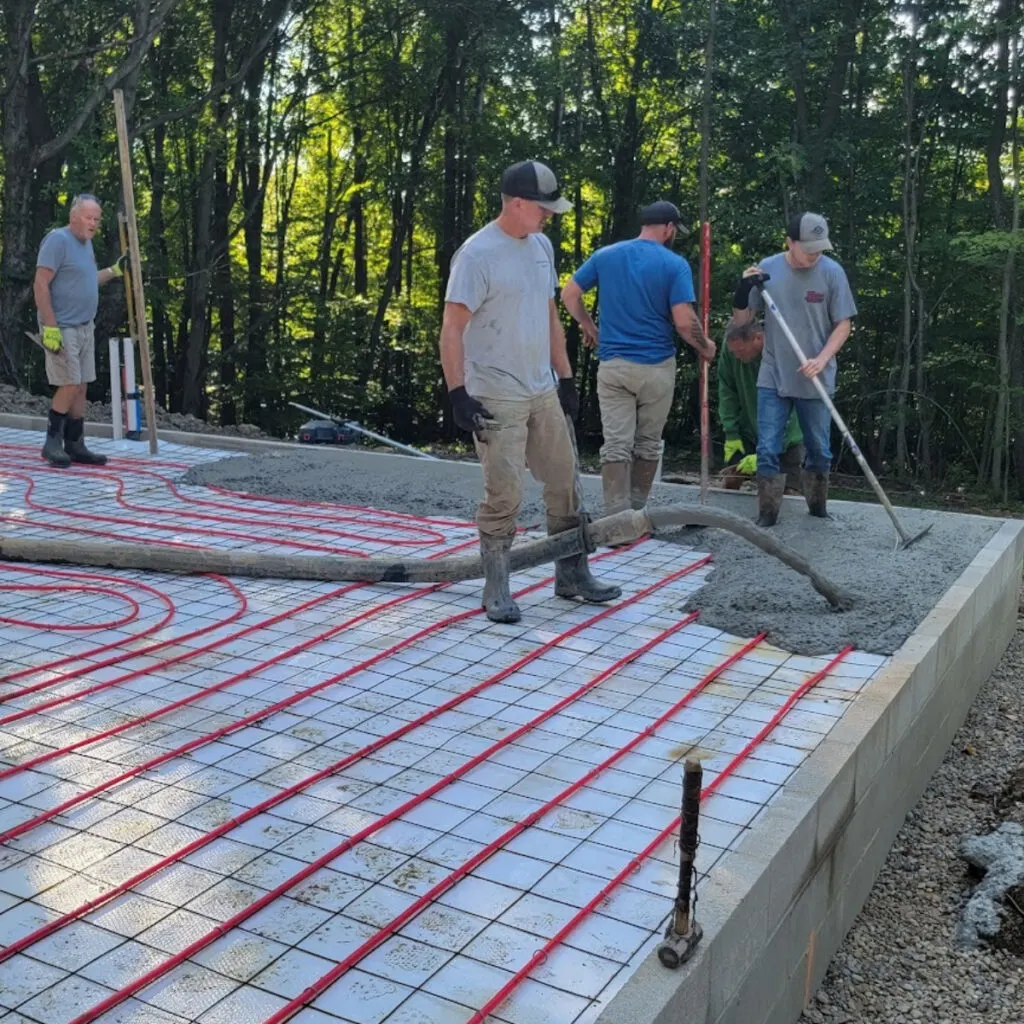
How It Installs – On Demand Radiant Floor Heat
Before a slab is poured, a looping pattern of plastic tubing (pex tubing) is laid on foam insulating sheets and the tubes are then secured with large staples. Next, the concrete is poured on top. In essence, the tubing becomes the duct work of the system.
Once the house framing is complete, the tubes are then connected to a wall-mounted, on-demand gas-fired water heater. Not only does the system act as our furnace, but it is also our hot water provider too. The lines to the showers, sinks, and anywhere we need hot water come out from a separate baffle within the unit.
Again, even a boiler or hot water floor system is efficient for heating the tubes and the floor. But by using an on demand system, we eliminate any need for a tank at all. Both for the floor, and for our hot water needs in the house.
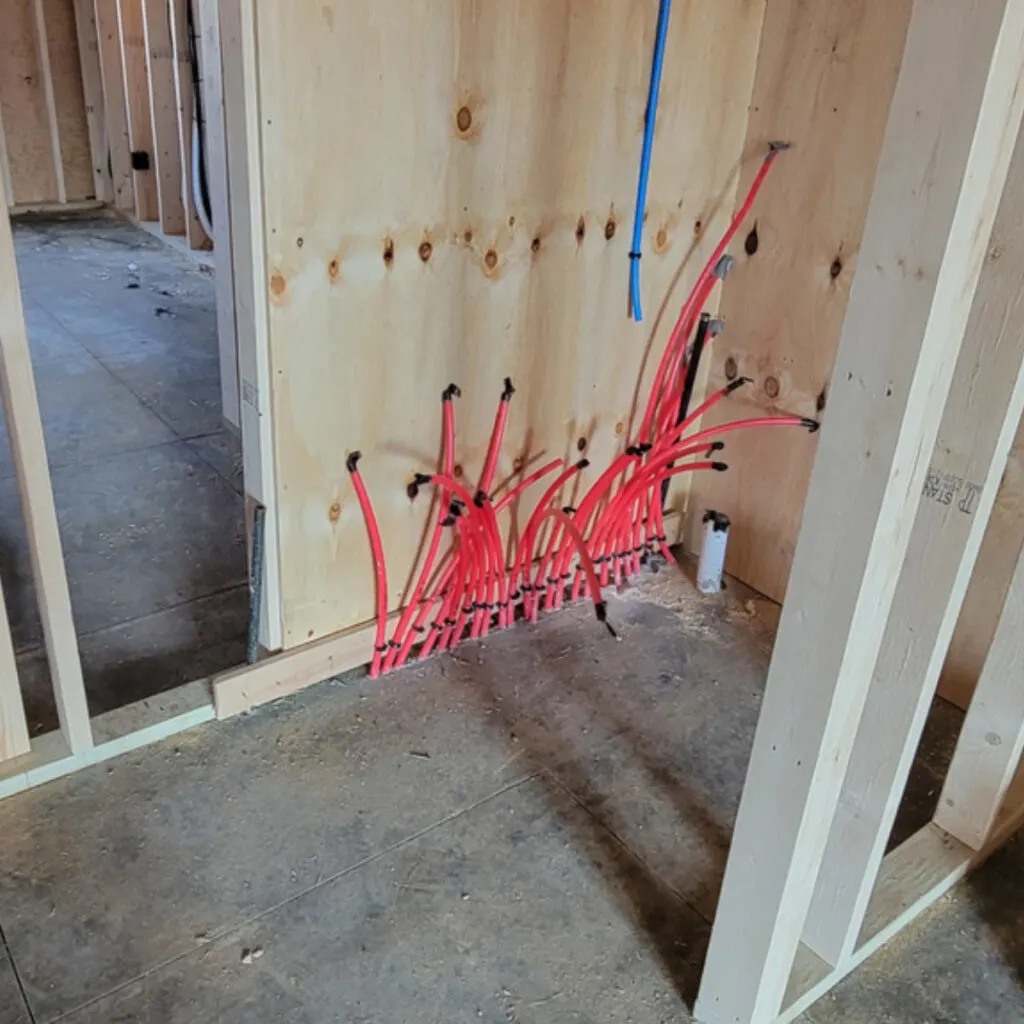
We have used both Rinnai and Navien gas fired units in our buildings and have had good success with both. There are a lot of units on the market that provide all kinds of options, which makes it nice for finding the right unit for the right application. Affiliate Link: Rinnai Whole Home Heating and Water Propane Heater.
Size & Cost
Most of these heating units measure around 28″ x 20″. They take up much less space than a hot water tank, let alone an entire furnace. It also happens to be extremely quiet when in operation.
As for cost, the tubing and on demand system together were less than we would have paid for a single budget furnace unit. Let alone having to buy and install HVAC, a hot water heater and more. As an example, the tubing and unit for our barndominium home was around $8700.00 total including installation. See: Barndominium Project
How It Works – On Demand Radiant Floor Heat
So how does an on demand floor heating system operate? To activate the floor heat, you simply turn the thermostat up. When you do, it begins to slowly heat the floor. It does this by circulating the hot water through the tubes. This then radiates the heat upward into the room.
We all know that heat rises, so by having the heat starting at the lowest point, the system already has an advantage. Once the floor is warm, the water circulates through, only heating when the thermostat falls below the range set.
Unlike a traditional furnace, a radiant floor heat system is constant. The heat is always coming up. When a door opens or a window opens, hot air exits, but more radiates up quickly. For us, it is so nice not to hear the furnace kick on as soon as cold air enters a space!
We turn our system on in early fall as it begins to get cold, and it stays on until mid spring as it warms. It only heats when needed, and without the worry of using tons of fuel. Best of all, no changing furnace filters, and no worrying about a furnace kicking on to blow dust everywhere.
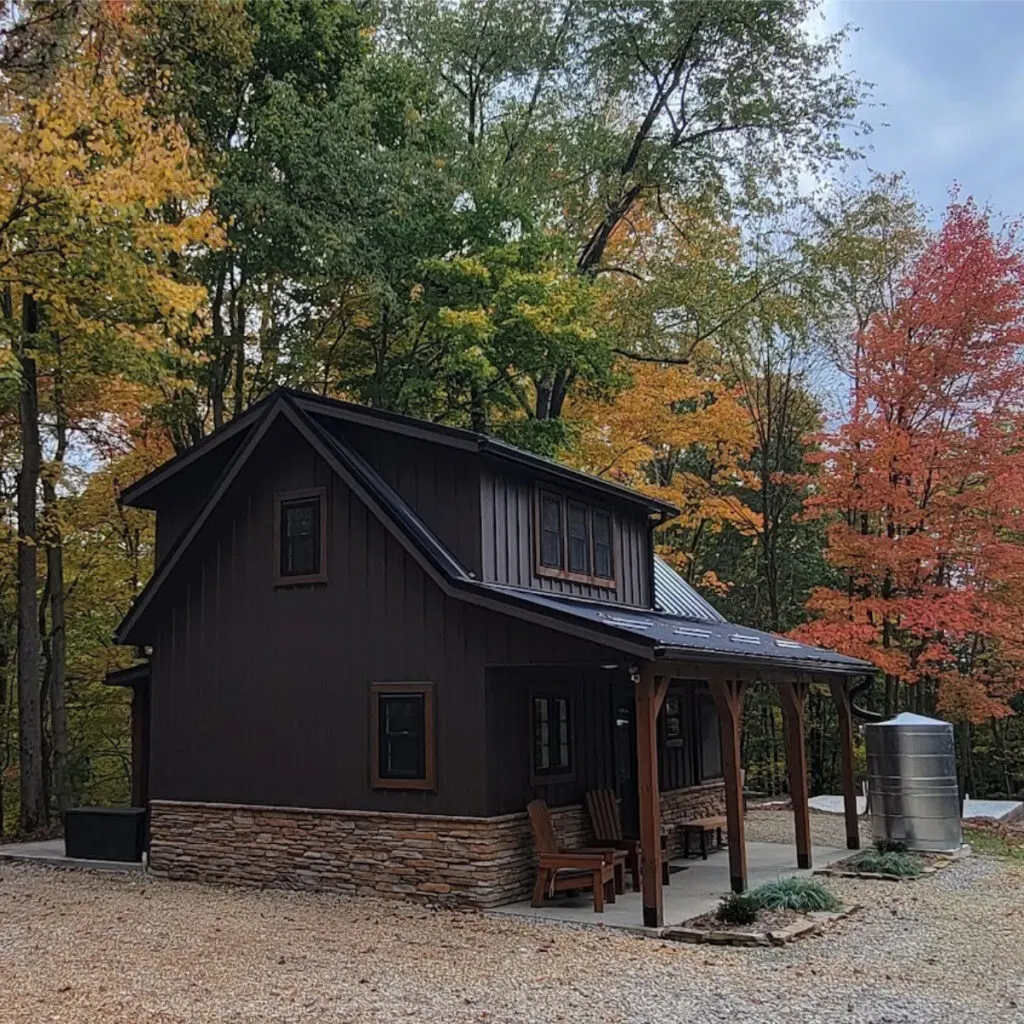
Final Features – How To Heat A House Cheap!
You could certainly tile or carpet over a concrete floor. But to save even more on our building cost, we turn the concrete slab for our home into our final floor with a few simple steps.
For starters, we had the concrete slab scored into 3 x 3′ “tiles” with saw cuts. This not only helps to eliminate the worry of cracks forming on the floor, but also gives a unique tile look to the floor. Next, to really bring out that tile look, we acid stain the concrete for a marbled look.
We loved the look so much, and the cost savings, we now do this in all of our builds. It is a great look, it’s durable, and best of all, very good on the budget! For more DIY projects around the home, be sure to check out: The Best Way To Hang Outdoor String Lights – Without Having Them Sag Or Break! – Jim and Mary
Jim and Mary Competti have been writing gardening, DIY and recipe articles and books for over 15 years from their 46 acre Ohio farm. The two are frequent speakers on all things gardening and love to travel in their spare time.
As always, feel free to email us at thefarm@owgarden.com with comments, questions, or to simply say hello! You can sign up for our free email list in the subscribe now box in the middle of this article. Follow us on Facebook here : OWG Facebook. This article may contain affiliate links.

